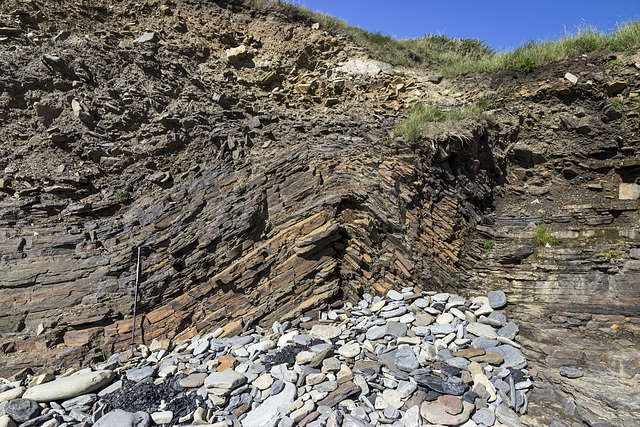West of Telpyn Point - fault in Telpyn Point Sands…
Cliff section east of Amroth 1
Cliff section east of Amroth 2
Raasay - Inver Bay panorama
Raasay: Morning view over Churchton Bay to Skye
Raasay: Morning view over Churchton Bay to the Bla…
Raasay: East Suisnish pier
Raasay: East Suisnish pier slipway 1
Raasay: East Suisnish pier - W L Byers anchor 1
Raasay: East Suisnish pier - W L Byers anchor 2
Raasay: Ironstone processing works - old office bl…
Raasay: Ironstone processing works - old office bl…
Raasay: Ironstone processing works - ore hopper an…
Raasay: Ironstone processing works - view down inc…
Raasay: Ironstone processing works - southern end…
Raasay: Inverarish from mine tramway
Raasay: Churchton Bay and Ben Tianavaig on Skye
Raasay: Churchton Bay, Ferry, and Ben Tianavaig on…
Conglomerates at Gravel Bay
Conglomerate at Gravel Bay: close-up view 1
Conglomerate at Gravel Bay: close-up view 2
Moody sky over Freshwater West
Spray haze over Freshwater West
Marros west - cryogenic anticline and solifluction…
Marros west - Teague's Wood and drift-filled valle…
Telpyn-Marros panorama
Marros west cliffs
Marros Sands and Top Castle hill fort panorama
Marros Sands panorama
The Settlands sand trees 3
Marros Sands
The Settlands sand trees 2
The Settlands sand trees 1
Little Settlands - inverted thin coals and disturb…
Little Settlands - incompetent deformation 2
Little Settlands - incompetent deformation 1
Little Haven - The Settlands; detail of overturned…
Little Haven - The Settlands; detail of incompeten…
Little Haven - The Settlands; detail of incompeten…
Little Haven - The Settlands; detail of southern a…
Little Haven - The Settlands; recumbent fold, thru…
Little Haven - The Settlands; recumbent fold, thru…
Little Haven - The Settlands panorama - geological…
Little Haven - The Settlands panorama
Fox Hole Anticline - northern limb with mine adit
1/100 • f/8.0 • 15.0 mm • ISO 100 •
Canon EOS 600D
EF-S15-85mm f/3.5-5.6 IS USM
Location
See also...
Keywords
Authorizations, license
-
Visible by: Everyone -
All rights reserved
-
114 visits
Marros west - cryogenic anticline and solifluction deposits 2


Marros Sands to Amroth
Just east of Amroth, we cross the county boundary into Carmarthenshire. The fine beach of Marros Sands, some 4 km east of Amroth is relatively isolated between Telpyn Point and Ragwen Point. There is no road access; the only way to get here is along the coastal paths, along the beach at lowest tide, or by boat.
At the western end of Marros Sands the Teague's Wood valley cuts down to the beach. The valley centre is filled with solifluction deposits ('Head') formed by freeze-thaw cycles of permafrost melting and refreezing at the end of the last glacial period (Devensian).
This is a closer view of the cryogenic anticlinal fold in the shales of the Bishopton Mudstone Formation The fold is probably due to valley bulging during melting of the permafrost. The fold is quite superficial and probably does not extend more than a few metres into the sub-surface.
Overlying the shales are angular, frost-shattered, shale fragments, possibly with some upward pointing ice-wedging structures. This is overlain in turn by a paler, angular, solifluction 'Head' and modern river alluvium, mostly sand with rounded pebbles and cobbles. See notes.
The walking stick is approx. 90 cm long
Just east of Amroth, we cross the county boundary into Carmarthenshire. The fine beach of Marros Sands, some 4 km east of Amroth is relatively isolated between Telpyn Point and Ragwen Point. There is no road access; the only way to get here is along the coastal paths, along the beach at lowest tide, or by boat.
At the western end of Marros Sands the Teague's Wood valley cuts down to the beach. The valley centre is filled with solifluction deposits ('Head') formed by freeze-thaw cycles of permafrost melting and refreezing at the end of the last glacial period (Devensian).
This is a closer view of the cryogenic anticlinal fold in the shales of the Bishopton Mudstone Formation The fold is probably due to valley bulging during melting of the permafrost. The fold is quite superficial and probably does not extend more than a few metres into the sub-surface.
Overlying the shales are angular, frost-shattered, shale fragments, possibly with some upward pointing ice-wedging structures. This is overlain in turn by a paler, angular, solifluction 'Head' and modern river alluvium, mostly sand with rounded pebbles and cobbles. See notes.
The walking stick is approx. 90 cm long
- Keyboard shortcuts:
Jump to top
RSS feed- Latest comments - Subscribe to the comment feeds of this photo
- ipernity © 2007-2024
- Help & Contact
|
Club news
|
About ipernity
|
History |
ipernity Club & Prices |
Guide of good conduct
Donate | Group guidelines | Privacy policy | Terms of use | Statutes | In memoria -
Facebook
Twitter

Sign-in to write a comment.